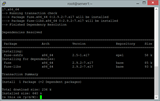Installige Plesk operatsioonisüsteemi CentOS 7
Kas kasutate teistsugust süsteemi? Plesk on patenteeritud veebihosti juhtpaneel, mis võimaldab kasutajatel hallata oma isiklikke ja/või klientide veebisaite, andmebaase
LUKS (Linux Unified Key Setup) on üks erinevatest Linuxi jaoks saadaolevatest ketta krüptimise vormingutest, mis on platvormi agnostiline. See õpetus annab teile juur- ja vahetuspartitsioonid LVM-i (Linux Volume Manager) köite sees, mis asub krüptitud LUKS-i partitsioonis. See õpetus võimaldab teil ka LUKS-i partitsiooni kaugjuhtimisega avada, kasutades lihtsustatud SSH-serveri deemonit, kasutades mis tahes ühilduvat SSH-klientprogrammi.
Lehel Serverite juurutamine tehke järgmist.
Server Locationjaotisest oma serveri asukoht .CentOS7jaotise ISO Libraryvahekaardi alt Server Type.Server Size.Deploy Nownuppu.Kasutage View Consolesuvandit, et pääseda juurde VPS-i eksemplarile noVNC-konsooli kaudu.
Valige Install CentOS Linux 7suvand.
Vajutage Tabklahvi.
Sisestage textpärast vmlinuz initrd=initrd.img inst.stage2=hd:LABEL=CentOS\x207\x20\86_64 quiet, et see näeks välja selline, vmlinuz initrd=initrd.img inst.stage2=hd:LABEL=CentOS\x207\x20\86_64 quiet textja vajutage Enterklahvi.
VPS käivitub nüüd tekstirežiimis CentOS-i installiprogrammi. Näete noVNC-konsoolis ekraani, nagu on näidatud alloleval pildil.

Kasutage seda Alt + Right Arrow Keykombinatsiooni TTY2-konsooli navigeerimiseks ja käsureale käskude tippimiseks.
Tippige allpool järgmised käsud, et luua partitsioon GRUB2 alglaaduri, krüptimata /bootpartitsiooni ja LUKS-i partitsiooni hoidva esmase partitsiooni jaoks.
parted -a opt -s /dev/vda mklabel gpt
parted -s /dev/vda unit mb
parted -s /dev/vda mkpart primary 1 3
parted -s /dev/vda name 1 grub
parted -s /dev/vda set 1 bios_grub on
parted -s /dev/vda mkpart primary 3 259
parted -s /dev/vda name 2 boot
parted -s /dev/vda mkpart primary 259 100%
parted -s /dev/vda name 3 root
Sektsiooni paigutuse kuvamiseks tippige järgmine käsk.
parted -s /dev/vda print
Järgmisena täitke nimetatud rootfspartitsioon pseudojuhuslike andmetega. Selle täitmiseks kulub veidi üle poole tunni.
dd if=/dev/urandom of=/dev/vda3 bs=1M status=progress
CentOS 7 puhul kasutavad cryptsetupkäsud vaikešifrit aes-xts-plain64, võtme vaikesuurust 256 bitti ja vaikeräsi SHA1. Selle asemel luuakse LUKS-i partitsioon turvalisema Serpenti šifriga, mille võtme suurus on 512 bitti ja Whirlpooli räsi abil.
cryptsetup luksFormat /dev/vda3 -c serpent-xts-plain64 -h whirlpool -s 512
Sisestage vastused, kui teil palutakse esitada järgmised päringud, ja seejärel vajutage Enterklahvi:
YESstrong-passwordstrong-passwordHoiatus See võimaldab root sisselogimist ja kopeerimist ilma parooli küsimata. Lõpetage see SSH-server pärast /tmp/luks-header-backup.imgfaili allalaadimist .
Säilitamiseks salvestage LUKS-i partitsiooni päise koopia. See tagab, et kui teie LUKS-i partitsiooni päis on kuidagi kahjustatud, saab selle taastada. Kui päis on ilma töötava varukoopiata kahjustatud, lähevad teie andmed igaveseks kaotsi.
cryptsetup luksHeaderBackup /dev/vda3 --header-backup-file /tmp/luks-header-backup.img
Faili kopeerimiseks /tmp/luks-header-backup.imgserverist tuleb ajutiselt käivitada SSH-server, kasutades selle scphankimiseks turvalist käivitatavat koopiat kliendi hostis.
SSH-hostivõtmete genereerimiseks tippige allpool järgmine käsk.
sshd-keygen
/etc/ssh/sshd_configFaili loomiseks tippige allpool järgmine käsk .
cp /etc/ssh/sshd_config.anaconda /etc/ssh/sshd_config
/etc/ssh/sshd_configFaili redigeerimiseks tippige allpool järgmine käsk .
vi /etc/ssh/sshd_config
Faili redigeerimiseks vajutage Insertklahvi ja kasutage nooleklahve, et liikuda faili redigeerimist vajavate osade juurde.
Kooskõlas üks, arvu muuta Port 22vaikimisi on 22, et juhusliku hulga oma valida 1025ja 65535. (Näide: port 25782)
Kerige alla rea number kolmteist, vajutage Endklahvi ja vajutage Enterklahvi.
Järgmisel real lisage HostKey /etc/ssh/ssh_host_ed25519_keyja vajutage Enterklahvi.
Järgmisel real lisage HostKey /etc/ssh/ssh_host_rsa_keyja vajutage Enterklahvi.
Vajutage Escklahvi, tippige :wqja vajutage Enterfaili salvestamiseks klahvi.
Vaikimisi võrguliides eth0vajab IP-aadressi. Tippige allpool järgmine käsk, et määrata oma eksemplarile loetletud IP-aadress eth0võrguliidesele.
dhclient
Määratud IP-aadressi kuvamiseks tippige järgmine käsk. IP-aadress kuvatakse vahetult pärast inetja enne netmask. (Näide: ineti 192.0.2.1võrgumask)
ifconfig eth0
SSH-serveri käivitamiseks tippige järgmine käsk.
/usr/sbin/sshd
Kui kasutate scpkäsku kliendi masina käsurealt, kasutage /tmp/luks-header-backup.imgfaili toomiseks mallina allolevat käsku . Asendage 25782tegeliku pordinumbriga, mis on määratud jaotises /etc/ssh/sshd_config. Asendage 192.0.2.1tegelikult määratud IP-aadressiga.
scp -P 25782 [email protected]:/tmp/luks-header-backup.img .
Pärast luks-header-backup.imgfaili allalaadimist tapke kohe SSH-server, tippides noVNC konsooli aknasse alloleva käsu.
killall sshd
Avage LUKS-i partitsioon, et seadistada sees asuv LVM-i füüsiline köide.
cryptsetup luksOpen /dev/vda3 centos
LUKS-i partitsiooni avamiseks, kui seda küsitakse, Entersisestage varem loodud parool, seejärel vajutage klahvi.
Sisestage parool /dev/vda3:strong-password
Tippige alla järgmine käsk:
ls /dev/mapper
See sisaldab järgmisi faile nimega centos, control, live-baseja live-rw. See centoson LUKS-i partitsioon.
LVM-i füüsilise köite loomiseks tippige allpool järgmine käsk.
pvcreate /dev/mapper/centos
Kui see õnnestub, saate järgmise teate:
Physical volume "/dev/mapper/centos" successfully created
LVM-i köiterühma loomiseks tippige allpool järgmine käsk.
vgcreate ssd /dev/mapper/centos
Kui see õnnestub, saate järgmise teate:
Volume group "ssd" successfully created
Swap-partitsiooni LVM-i loogilise köite loomiseks tippige allpool järgmine käsk. Kasutage oma VPS-i eksemplari põhjal vajaliku suurusega vahetuspartitsiooni loomiseks mõistlikku otsust (-L = helitugevuse suurus).
lvcreate -L 1G -n swap ssd
Kui see õnnestub, saate järgmise teate:
Logical volume "swap" created
Type the following command below to create a LVM logical volume for the root partition. This will use the remaining free space while reserving five percent (5%) to contain LVM snapshots of your logical volumes if you so choose.
lvcreate -l 95%FREE -n root ssd
When successful, you will receive the following message:
Logical volume "root" created
Display the LVM physical volume.
pvdisplay
You will see text in the noVNC console similar to what is pictured in the image below.

Display the LVM volume group.
vgdisplay
You will see text in the noVNC console similar to what is pictured in the image below.

Display the LVM logical volume(s).
lvdisplay
You will see text in the noVNC console similar to what is pictured in the image below.

Type the following command below to deactivate the LVM volume group. This must be completed in order to allow cryptsetup to close the LUKS partition in the next step.
vgchange -a n
When successful, you will receive the following message:
0 logical volume(s) in volume group "ssd" now active
Close the LUKS volume.
cryptsetup luksClose centos
Type the following command below:
ls /dev/mapper
It will contain the following files named control, live-base and live-rw. The centos file, containing the LUKS partition, will be missing to ensure that that it was closed properly.
Type reboot and press the Enter key to reboot.
Select the Install CentOS Linux 7 option and press the Enter key.
The VPS will now boot into the GUI mode CentOS installer. You will see a screen in the noVNC console like pictured in the image below. Select Install CentOS 7 (1) and press the Enter key.

On the WELCOME TO CENTOS 7 screen, click the blue Continue button (1).

Attention If you're not using the default language of English and the locale of the United States, input your language in the search bar (1). Click on the language (2) and the appropriate locale (3) associated with it. When satisfied, click the blue Continue button (4).

On the INSTALLATION SUMMARY screen, click on INSTALLATION DESTINATION (Automatic partitioning selected) (1) under SYSTEM.

On the INSTALLATION DESTINATION screen, select the I will configure partitioning (1) option under Other Storage Options (Partitioning) and click the blue Done button (2) at the top left of the screen.

On the MANUAL PARTITIONING screen, click on the Unknown expandable accordion (1). It will reveal three partitions named BIOS Boot (vda1), Unknown (vda2) and Encrypted (LUKS) (vda3).

With the BIOS Boot partition highlighted in blue (1), select the checkbox option of Reformat (2) next to the File System: accordion and click the Update Settings button (3).

Click on the Unknown partition (1) so that it is highlighted in blue. Select the checkbox option of Reformat (2) next to the File System: accordion. Select ext2 in the File System: accordion (3), enter /boot in the text field (4) under Mount Point:, enter boot in the text field (5) under Label: and click the Update Settings button (6).

Click on the Encrypted (LUKS) partition (1) so that it is highlighted in blue. Enter the passphrase you created for LUKS partition in Step 3: Setup LVM On LUKS Full Disk Encryption in the Passphrase: text field (2) and click the Unlock button (3).

A new Unknown expandable accordion (1) will appear. It will reveal two partitions named Unknown (ssd-root) and Unknown (ssd-swap).

With the Unknown (ssd-root) partition (1) highlighted in blue, select the checkbox option of Reformat (2) next to the File System: accordion. Select xfs in the File System: accordion (3), enter / in the text field (4) under Mount Point:, enter root in the text field (5) under Label: and click the Update Settings button (6).

Click on the Unknown (ssd-swap) (1) partition so that it is highlighted in blue. Select the checkbox option of Reformat (2) next to the File System: accordion. Select swap in the File System: accordion (3), enter swap in the text field (4) under Label: and click the Update Settings button (5).

Click the blue Done button (1) at the top left of the screen.

A box named SUMMARY OF CHANGES will pop up. Click the Accept Changes button (1). This will bring you back to the WELCOME TO CENTOS 7 screen.

Click on NETWORK & HOST NAME (Not connected) (1) under SYSTEM.

On the NETWORK & HOST NAME screen, move the slider (1), next to the right of Ethernet(eth0) field, from the OFF position to the ON position. If you want to use a custom hostname instead of the default (192.0.2.1.vultr.com) in the Host name: text box (2), change it. Click the blue Done button (3) at the top left of the screen. This will bring you back to the WELCOME TO CENTOS 7 screen.

When you are satisfied with the options on the WELCOME TO CENTOS 7 screen, click the blue Begin Installation button (1).

On the CONFIGURATION screen, click on ROOT PASSWORD (Root password is not set) (1) under USER SETTINGS.

On the ROOT PASSWORD screen, enter a strong password in both the Root Password: (1) and Confirm: (2) text fields. Click the blue Done button (3) at the top left of the screen. This will bring you back to the CONFIGURATION screen.

On the CONFIGURATION screen, click on USER CREATION (No user will be created) (1) under USER SETTINGS.

On the CREATE USER screen, enter your full name in the Full name text field (1), an username in the User name text field (2), a strong password in both the Password (3) and Confirm password (4) text fields. Click on the Advanced... button (5).

A box named ADVANCED USER CONFIGURATION will pop up. In the Add user to the following groups: text field (1) under Group Membership, enter wheel and click the Save Changes button (2).

Click the blue Done button (1) at the top left of the screen.

The post-installation process will now commence. It will take a few minutes to complete. When it is finished, click on the blue Reboot button (1) to reboot your VPS instance.

Navigate back to the VULTR Server Management Screen. Click on the Settings link at the top. Click on Custom ISO on the menu on the left side. On the Custom ISO page, click on the Remove ISO button to unmount the ISO and reboot into your CentOS 7 VPS instance. Click the OK button when prompted and the VPS instance will reboot.
Navigate back to the View Console window to access the VPS instance via the noVNC console. Refresh the window if noVNC has disconnected.
You will be prompted to enter the passphrase (Example: Please enter passphrase for disk primary (luks-xxxxxxxx-xxxx-xxxx-xxxx-xxxxxxxxxxxx)!:) you created for LUKS partition in Step 3: Setup LVM On LUKS Full Disk Encryption. Enter the passphrase and press the Enter key.

You will then be presented with the console login prompt. You can now close the noVNC console window.
Log in via SSH with a regular user and update the system as follows.
sudo yum install epel-release -y
sudo yum clean all && sudo yum update -y
While still logged in as a regular user, type the following commands below to install dracut-crypt-ssh.
sudo yum install wget -y
sudo wget -O /etc/yum.repos.d/rbu-dracut-crypt-ssh-epel-7.repo https://copr.fedorainfracloud.org/coprs/rbu/dracut-crypt-ssh/repo/epel-7/rbu-dracut-crypt-ssh-epel-7.repo
sudo yum install dracut-crypt-ssh -y
Type the following command below to install the nano editor to ease editing of files.
sudo yum install nano -y
You will need to edit the default grub file located in /etc/default/grub.
sudo nano /etc/default/grub
Insert rd.neednet=1 ip=dhcp between GRUB_CMDLINE_LINUX="crashkernel=auto and rd.luks.uuid=luks-xxxxxxxx-xxxx-xxxx-xxxx-xxxxxxxxxxxx.
Save the file by entering the following keyboard combinations. Press the Ctrl + x keys, press the y key and press the Enter key.
Regenerate you GRUB configuration file by type the command below.
sudo grub2-mkconfig -o /etc/grub2.cfg
Backup the original /etc/dracut.conf.d/crypt-ssh.conf by typing the following command below.
sudo mv /etc/dracut.conf.d/crypt-ssh.conf /etc/dracut.conf.d/crypt-ssh.conf.orig
Create a new /etc/dracut.conf.d/crypt-ssh.conf file by typing the following command below.
sudo nano /etc/dracut.conf.d/crypt-ssh.conf
Copy and paste the following text below into the nano editor.
dropbear_acl="/etc/dropbear/keys/authorized_keys"
dropbear_ecdsa_key="/etc/dropbear/keys/ssh_ecdsa_key"
dropbear_rsa_key="/etc/dropbear/keys/ssh_rsa_key"
Create the directory keys under /etc/dropbear/, with the necessary directory permissions, that will hold the authorized_keys, ssh_ecdsa_key and ssh_rsa_key files.
sudo mkdir /etc/dropbear/keys/; sudo chmod /etc/dropbear/keys/
Generate the ssh_ecdsa_key and ssh_rsa_key files with the ssh_keygen program by typing the following commands below. Press the Enter key twice, for each command, when prompted for passphrases.
sudo ssh-keygen -t ecdsa -f /etc/dropbear/keys/ssh_ecdsa_key
sudo ssh-keygen -t rsa -f /etc/dropbear/keys/ssh_rsa_key
Change the file permissions on ssh_ecdsa_key, ssh_ecdsa_key.pub, ssh_rsa_key and ssh_rsa_key.pub by typing the command below.
sudo chmod 400 /etc/dropbear/keys/*_key; sudo chmod 444 /etc/dropbear/keys/*.pub
Generate public keys using the How Do I Generate SSH Keys? tutorial, found at the beginning of the tutorial under Prerequisites, for your prospective client operating system.
Copy and paste all the text in the public key into the /etc/dropbear/keys/authorized_keys file using the nano program by typing the command below.
sudo nano /etc/dropbear/keys/authorized_keys
You must first build the initramfs and any subsequent update of the dracut-crypt-ssh configuration. Type the following command below for the initial build of the initramfs.
sudo dracut -f
Once that's complete, your CentOS 7 install is set up to listen for your SSH client to connect and allow you to unlock the LUKS partition using your passphrase. You may now reboot your CentOS 7 instance by typing the command below.
sudo reboot
Oma kliendi süsteemide vaadake lõigud 3.3. Unlocking the volumes interactivelyja 3.4. Unlocking using theavamine commandon Dracut-Crypt-SSH GitHub leht kas jõu parooliga kiire või kasutada unlockkäsku avama oma LUKS partitsiooni oma SSH klient.
Kas kasutate teistsugust süsteemi? Plesk on patenteeritud veebihosti juhtpaneel, mis võimaldab kasutajatel hallata oma isiklikke ja/või klientide veebisaite, andmebaase
Squid on populaarne tasuta Linuxi programm, mis võimaldab teil luua edastamise veebipuhverserveri. Selles juhendis näete, kuidas installida Squid CentOS-i, et teid pöörata
Sissejuhatus Lighttpd on Apache'i hark, mille eesmärk on olla palju vähem ressursimahukas. See on kerge, sellest ka oma nimi, ja seda on üsna lihtne kasutada. Installin
VULTR on hiljuti teinud nende osas muudatusi ja kõik peaks nüüd töötama hästi, kui NetworkManager on lubatud. Kui soovite keelata
Icinga2 on võimas seiresüsteem ja kui seda kasutatakse põhikliendi mudelis, võib see asendada vajaduse NRPE-põhiste seirekontrollide järele. Meister-klient
Kas kasutate teistsugust süsteemi? Apache Cassandra on tasuta ja avatud lähtekoodiga NoSQL-i andmebaasihaldussüsteem, mis on loodud pakkuma skaleeritavust, hig.
Kas kasutate teistsugust süsteemi? Microweber on avatud lähtekoodiga pukseeritav CMS-i ja veebipood. Microweberi lähtekoodi majutatakse GitHubis. See juhend näitab teile
Kas kasutate teistsugust süsteemi? Mattermost on avatud lähtekoodiga isehostitav alternatiiv Slack SAAS-i sõnumsideteenusele. Teisisõnu, Mattermostiga saate ca
Mida vajate Vultr VPS-i, millel on vähemalt 1 GB muutmälu. SSH-juurdepääs (juur-/administraatoriõigustega). 1. samm: BungeeCordi installimine Kõigepealt
Pleski juhtpaneelil on Lets Encrypti jaoks väga kena integratsioon. Lets Encrypt on üks ainsatest SSL-i pakkujatest, kes väljastab sertifikaate täielikult
Lets Encrypt on sertifitseerimisasutus, mis on pühendunud SSL-sertifikaatide tasuta pakkumisele. cPanel on teie ja teie kliendi jaoks loonud korraliku integratsiooni
Kas kasutate teistsugust süsteemi? Concrete5 on avatud lähtekoodiga CMS, mis pakub palju eristatavaid ja kasulikke funktsioone, mis aitavad toimetajatel sisu hõlpsalt luua.
Kas kasutate teistsugust süsteemi? Review Board on tasuta avatud lähtekoodiga tööriist lähtekoodi, dokumentatsiooni, piltide ja palju muu ülevaatamiseks. See on veebipõhine tarkvara
In this guide, you will learn how to setup HTTP authentication for an Nginx web server running on CentOS 7. Requirements To get started, youll need th
YOURLS (Your Own URL Shortener) on avatud lähtekoodiga URL-i lühendamise ja andmeanalüüsi rakendus. Selles artiklis käsitleme installimisprotsessi
Kas kasutate teistsugust süsteemi? Sissejuhatus ArangoDB on avatud lähtekoodiga NoSQL-i andmebaas, millel on paindlik andmemudel dokumentide, graafikute ja võtmeväärtuste jaoks. see on
Sissejuhatus Kataloog /etc/ mängib Linuxi süsteemi toimimises kriitilist rolli. Selle põhjuseks on peaaegu iga süsteemi konfiguratsioon
Paljud süsteemiadministraatorid haldavad suuri servereid. Kui failidele on vaja juurde pääseda erinevatest serveritest, logige igasse eraldi sisse ca
See õpetus hõlmab Half Life 2 mänguserveri installimist süsteemi CentOS 6 System. 1. samm: eeltingimuste installimine Ou seadistamiseks
Laravel GitScrum ehk GitScrum on avatud lähtekoodiga produktiivsuse tööriist, mis on loodud selleks, et aidata arendusmeeskondadel rakendada Scrumi metoodikat sarnasel viisil.
Tehisintellekt ei ole tulevik, see on siin, olevikus. Sellest blogist loe, kuidas tehisintellekti rakendused on mõjutanud erinevaid sektoreid.
Kas olete ka DDOS-i rünnakute ohver ja olete segaduses ennetusmeetodite osas? Oma päringute lahendamiseks lugege seda artiklit.
Võib-olla olete kuulnud, et häkkerid teenivad palju raha, kuid kas olete kunagi mõelnud, kuidas nad sellist raha teenivad? arutleme.
Kas soovite näha Google'i revolutsioonilisi leiutisi ja seda, kuidas need leiutised muutsid iga inimese elu tänapäeval? Seejärel lugege ajaveebi, et näha Google'i leiutisi.
Isejuhtivate autode kontseptsioon tehisintellekti abil teedele jõudmiseks on meil juba mõnda aega unistus. Kuid vaatamata mitmele lubadusele pole neid kusagil näha. Lisateabe saamiseks lugege seda ajaveebi…
Kuna teadus areneb kiiresti, võttes üle suure osa meie jõupingutustest, suureneb ka oht, et allume seletamatule singulaarsusele. Loe, mida singulaarsus meie jaoks tähendada võiks.
Andmete säilitamise meetodid on arenenud alates andmete sünnist. See ajaveeb käsitleb infograafiku alusel andmete salvestamise arengut.
Lugege ajaveebi, et kõige lihtsamal viisil teada saada Big Data Architecture'i erinevaid kihte ja nende funktsioone.
Selles digipõhises maailmas on nutikad koduseadmed muutunud elu oluliseks osaks. Siin on mõned nutikate koduseadmete hämmastavad eelised, mis muudavad meie elu elamisväärseks ja lihtsamaks.
Hiljuti andis Apple välja macOS Catalina 10.15.4 täiendusvärskenduse probleemide lahendamiseks, kuid tundub, et värskendus põhjustab rohkem probleeme, mille tulemuseks on Maci masinate tellimine. Lisateabe saamiseks lugege seda artiklit








